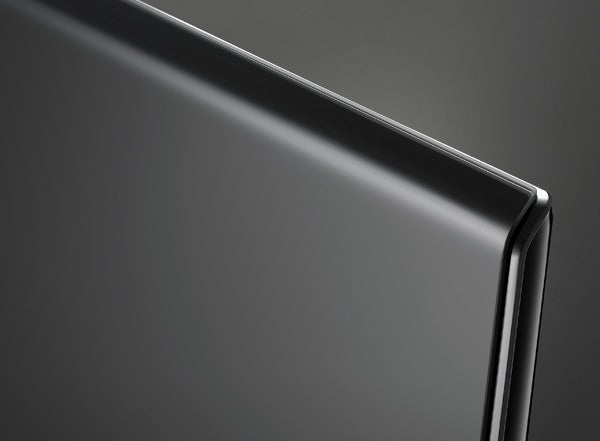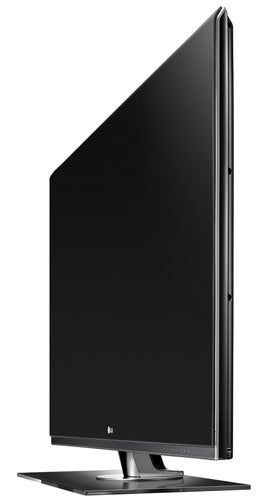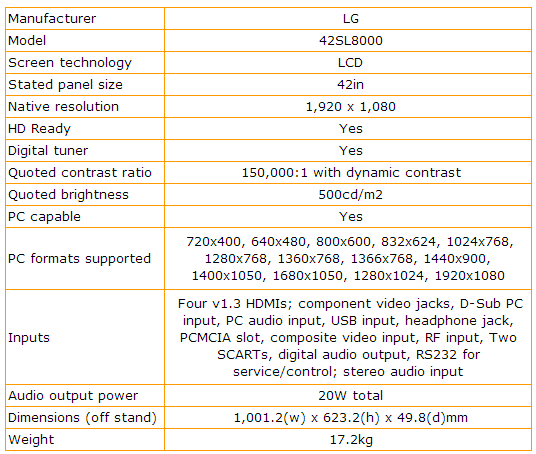LG 42SL8000 42in LCD TV Review
LG 42SL8000 42in LCD TV
Find out why we think the LG 42SL8000 is a truly outstanding 42in LCD TV.

Verdict
Key Specifications
- Review Price: £1000.00
Every now and then LG manages to get something over to us quite a bit ahead of its actual release date. And that’s precisely what’s happened today with the 42in 42SL8000, a TV not due to go on sale until later this month.
While we always appreciate the opportunity to get stuck into something early, there is a downside. Namely that no ‘real world’ prices are available for the 42SL8000 yet, so we’ve had to depend on educated guesswork and a couple of industry contacts to come up with the approximate £1,000 figure given at the top of the review.
But this is pretty much where the bad news about this review ends, for despite arriving with us more or less out of the blue, the 42SL8000 has turned out to be a bit of a star.
The good news begins as soon as you get the set out of the box. For the design is a paragon of slenderness, with a bezel that’s barely an inch across on three sides, and a rear end that only sticks out around 50mm – roughly half the butt size of a typical LCD TV.
Couple this thin profile with a typically flamboyant high-gloss, almost glass-like finish, some neat curves around the bezel’s edges, and even a flourish of subtle blue colouration along the TV’s undercarriage, and the 42SL8000 really does boast impressive shop-shelf appeal.
In typical LG style, though, the 42SL8000 doesn’t trade on its looks alone. In fact, it’s packed to bursting point with features and promisingly potent specifications.
Take its connections, for instance. They tick pretty much all of our favourite boxes by including four HDMIs, a dedicated VGA computer port, and a USB port that can handle DivX 1080p, WMV, and other video file formats as well as the more typical JPEGs and MP3s.
Hardcore gadget hounds might also appreciate the set’s Bluetooth support, allowing you to transfer wirelessly music and photos from Bluetooth phones to the TV. Or else you can listen to the TV’s sound via a set of Bluetooth headphones.
The next thing to catch our eye about the 42SL8000 is its 200Hz processing system, provided to increase the clarity and fluidity of motion reproduction. I’m duty bound to point out here, though, that calling the feature 200Hz is a little optimistic, as the TV doesn’t actually refresh its screen 200 times a second, like Samsung and Sony’s 200Hz TVs do. Instead it uses a 100Hz refresh rate in conjunction with a scanning backlight arrangement, to produce a 200Hz-like effect.
This doesn’t mean that the 42SL8000 won’t necessarily be able to produce pictures with hugely improved motion, but it does mean we need to be on the look out for artefacts associated with scanning backlights, such as multiple echoes of small moving objects, and flickering over patches of fine HD detail.
Joining the 200Hz system in presenting us with some attractive ‘numbers’ are the 42SL8000’s Full HD resolution, and a contrast ratio of 150,000:1 that’s one of the highest we’ve seen from a non-LED, non-plasma TV.
As ever, such contrast ratios have to be taken with a hefty pinch of salt. But the fact that the 150,000:1 figure is way higher than anything seen from previous LG LCD TVs at least raises hopes that the TV will produce LG’s best LCD black levels yet, overcoming the Korean brand’s usual shortcomings in this crucial area.
Final bits and bobs worth running by you are: the 42SL8000’s XD Engine video processor – a proprietary, multi-facetted LG system that’s delivered solid if unspectacular results in the past; LG’s RealCinema processor for enhanced Blu-ray playback; processors for enhancing colour saturations and contrast; and the option to choose between standard and wide colour gamuts.
The list above actually represents just a small sample of the plethora of options available via the 42SL8000’s beautifully presented onscreen menus. In fact, so plentiful are the tweaks that the TV has been officially endorsed by the Imaging Science Foundation, meaning that the TV carries two ‘ISF’ picture preset modes an ISF engineer can use to store picture settings optimised to your specific room conditions.
If we’re honest, some LG TVs we’ve seen have slightly flattered to deceive, with their sultry good looks and eye-catching feature lists giving way to some pretty average performance standards. But thankfully, the 42SL8000 follows through on its up-front appeal with easily LG’s best picture quality to date.
As I’d hoped, for instance, it produces a black level response that’s not only streets ahead of LG’s usual standards, but up there with the best offered by any brand’s non-LED LCD TVs. Dark scenes in movies and console games suffer only a little with the grey clouding that’s still so common in the LCD world. What’s more, dark scenes retain enough subtle background and greyscale information to make them look full of depth.
Even something as relentlessly black as the stunning new ”Batman: Arkham Asylum” Xbox 360/PS3 game is a constant joy to behold.
As with the vast majority of other LCD TVs, the 42SL8000’s black levels do drop off quite a bit if you have to watch the screen from much of an angle. But if your main seating position is directly in front of your TV, you’re laughing.
Helping to make the 42SL8000’s new-found black level prowess look even more striking, meanwhile, is the impressive intensity and brightness of its colour response. LG LCD TVs have long excelled in this area, of course. But the improvement in black levels makes colours look even more dynamic, as well as making colour tones generally look more natural. Especially during dark scenes.
Another key element in the 42SL8000’s winning picture formula is its sharpness. HD sources – especially Blu-rays – look pristine, with endless amounts of fine detail, exceptionally smooth colour blends, and that tantalising ‘snap’ that makes HD so beloved of all who’ve witnessed it at its best.
The ‘200Hz’ engine contributes to the LG’s HD sharpness too, as I would have hoped. There’s practically no loss of resolution at all as objects cross the screen, and judder is hugely reduced, too. 
The 42SL8000’s 200Hz system isn’t quite as potent as those of Samsung and Sony’s ‘true’ 200Hz TVs. Plus its scanning backlight component does cause the sporadic appearance of the ‘three-ball’ phenomenon, where golf, cricket and tennis balls sometimes appear with a couple of ghostly echoes around them.
I’d recommend, too, that you only leave the 200Hz engine set to its ‘low’ level if you don’t want to find your pictures succumbing to lots of unwanted side effects, like flickering and localised lag around large moving objects.
Overall, though, while you should use it with caution, the 200Hz engine’s positives for me ultimately outweigh its negatives. What’s more, even if you decide to turn the system off completely for some fast-moving sports event, the 42SL8000’s picture still doesn’t prove very susceptible to LCD’s common blurring and judder phenomena.
Given that HD sadly still makes up the minority of our TV viewing time, it’s also great to find that the 42SL8000 is rather accomplished at rescaling standard definition to its Full HD pixel count. Colours retain their tonal authenticity much more during the rescaling process than we’ve become accustomed to seeing with LG TVs, and standard def images are sharpened without noise being excessively exaggerated.
Aside from the limited viewing angle issue and (largely avoidable) 200Hz artefacts mentioned earlier, the only negatives I could really come up with about the 42SL8000’s pictures are a slight tendency to over-sharpen some edges during very bright standard definition scenes, and the fact that the screen reflects ambient light from your room a little more obviously than I’d like.
The 42SL8000’s audio is better than I’d expected considering how slender the TV is. There’s much more raw power around than I’ve become accustomed to hearing from LG’s flat TVs, and this power is delivered without distortion or ‘muddiness’. High frequency sounds can occasionally sound a touch brittle, but otherwise it’s all more than satisfying. Especially if you’ve got the Clear Voice option engaged to soup up the reproduction of vocals.
”’Verdict”’
Thanks to the 42SL8000, LG now has a truly outstanding LCD performer to add to its already well-established value and design talents. If this is the shape of things to come for LG, we could be in for a very interesting and competitive ride in the lead up to Christmas…

How we test televisions
We test every TV we review thoroughly over an extended period of time. We use industry standard tests to compare features properly. We’ll always tell you what we find. We never, ever, accept money to review a product.
Trusted Score
Score in detail
-
Features 9
-
Value 10
-
Image Quality 9
-
Design 8
-
Sound Quality 8
Features
| Size (Inch) | 42in |
| Display Type | LCD |

